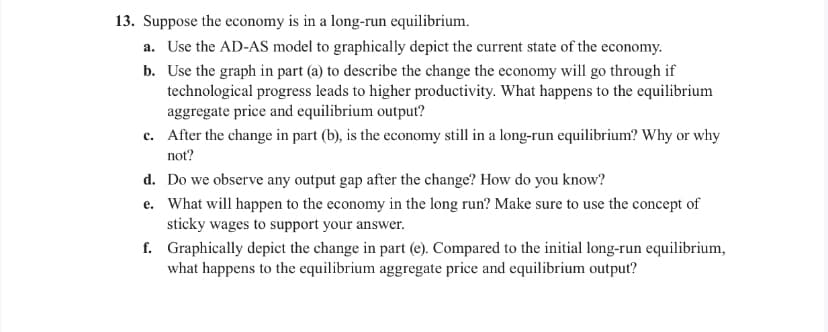13. Suppose the economy is in a long-run equilibrium. a. Use the AD-AS model to graphically depict the current state of the economy. b. Use the graph in part (a) to describe the change the economy will go through if technological progress leads to higher productivity. What happens to the equilibrium aggregate price and equilibrium output? c. After the change in part (b), is the economy still in a long-run equilibrium? Why or why not?
13. Suppose the economy is in a long-run equilibrium. a. Use the AD-AS model to graphically depict the current state of the economy. b. Use the graph in part (a) to describe the change the economy will go through if technological progress leads to higher productivity. What happens to the equilibrium aggregate price and equilibrium output? c. After the change in part (b), is the economy still in a long-run equilibrium? Why or why not?
Principles of Economics 2e
2nd Edition
ISBN:9781947172364
Author:Steven A. Greenlaw; David Shapiro
Publisher:Steven A. Greenlaw; David Shapiro
Chapter26: The Neoclassical Perspective
Section: Chapter Questions
Problem 21P: Use Table 26.3 to answer the following questions. Sketch an aggregate supply and aggregate demand...
Related questions
Question
Please be sure to explain why and how to the questions
-Thank you

Transcribed Image Text:13. Suppose the economy is in a long-run equilibrium.
a. Use the AD-AS model to graphically depict the current state of the economy.
b. Use the graph in part (a) to describe the change the economy will go through if
technological progress leads to higher productivity. What happens to the equilibrium
aggregate price and equilibrium output?
c. After the change in part (b), is the economy still in a long-run equilibrium? Why or why
not?
d. Do we observe any output gap after the change? How do you know?
e.
What will happen to the economy in the long run? Make sure to use the concept of
sticky wages to support your answer.
f.
Graphically depict the change in part (e). Compared to the initial long-run equilibrium,
what happens to the equilibrium aggregate price and equilibrium output?
Expert Solution
This question has been solved!
Explore an expertly crafted, step-by-step solution for a thorough understanding of key concepts.
This is a popular solution!
Trending now
This is a popular solution!
Step by step
Solved in 3 steps with 2 images

Knowledge Booster
Learn more about
Need a deep-dive on the concept behind this application? Look no further. Learn more about this topic, economics and related others by exploring similar questions and additional content below.Recommended textbooks for you

Principles of Economics 2e
Economics
ISBN:
9781947172364
Author:
Steven A. Greenlaw; David Shapiro
Publisher:
OpenStax

Economics: Private and Public Choice (MindTap Cou…
Economics
ISBN:
9781305506725
Author:
James D. Gwartney, Richard L. Stroup, Russell S. Sobel, David A. Macpherson
Publisher:
Cengage Learning

Macroeconomics: Private and Public Choice (MindTa…
Economics
ISBN:
9781305506756
Author:
James D. Gwartney, Richard L. Stroup, Russell S. Sobel, David A. Macpherson
Publisher:
Cengage Learning

Principles of Economics 2e
Economics
ISBN:
9781947172364
Author:
Steven A. Greenlaw; David Shapiro
Publisher:
OpenStax

Economics: Private and Public Choice (MindTap Cou…
Economics
ISBN:
9781305506725
Author:
James D. Gwartney, Richard L. Stroup, Russell S. Sobel, David A. Macpherson
Publisher:
Cengage Learning

Macroeconomics: Private and Public Choice (MindTa…
Economics
ISBN:
9781305506756
Author:
James D. Gwartney, Richard L. Stroup, Russell S. Sobel, David A. Macpherson
Publisher:
Cengage Learning

Brief Principles of Macroeconomics (MindTap Cours…
Economics
ISBN:
9781337091985
Author:
N. Gregory Mankiw
Publisher:
Cengage Learning

Essentials of Economics (MindTap Course List)
Economics
ISBN:
9781337091992
Author:
N. Gregory Mankiw
Publisher:
Cengage Learning
